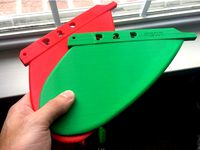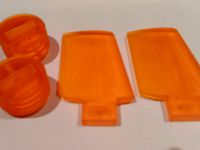GrabCAD

getWAVES
by GrabCAD
Last crawled date: 2 years ago
This is my entry to the Portable Stand Up Paddle Board Challenge. The challenge asked for 3D optimized, lightweight, and easy to transport. With these design requirements, I immediately thought about bodyboards. Living in Hawaii, there are a lot of people that surfs but also bodyboards. These boards are smaller and could be easily transported inside a small car and public transportation. With that said, I got my inspiration of my 3D SUP design from them.
My design is divided into three pieces. They are about the same size of a regular bodyboard (38”-42”). They are connected by 4” diameter screw plugs that are also 3D printed. The joints are designed so that there are minimal parts. For this case, there are only two screw plugs that will connect the board. Also, this will result into fast and ease of assembly. I wasn’t fond of using hinges or snap fits because I believe they can easily fail with overuse.
The design could be easily transported in a slightly modified bodyboard bag. This could be done by simply making the width of the bag bigger or making it stretchable. Like I said earlier, I have seen a lot of people especially cousins and friends using the bag inside a car or a bus with no hassle.
On SolidWorks, I applied polyethylene (PE) as the material on each part (three main parts, two screw plug, and three fins). The weight of each part are:
Nose/Top part= 4.9 lbs
Deck/Middle part= 7.6 lbs
Tail/Bottom part= 5.4 lbs
Plug= 0.8 (x2)= 1.6 lbs
Fin= 0.2 (x3)= 0.6 lbs
The total weight is 20.1 lbs. This is within the weight requirement. The renderings shows a friction pad but it wasn’t added to the total weight since users can just use surf wax.
The size of the fully assembled board is 9’-6” x 32” with 4” thickness. The minimum thickness of the board is 0.04” which is the recommended in this challenge. I made the screw plugs thicker since they will likely to see higher stress than the other parts. In addition, I optimized the design by adding rib structures inside the board. This would lessen the probability of it getting damages during transport, damages from hitting reefs, or collapsing with the weight of the user.
I learned a lot in challenge/project from researching SUP boards and different materials. I like the end result and I hope you guys like it too. Thank you for looking!
My design is divided into three pieces. They are about the same size of a regular bodyboard (38”-42”). They are connected by 4” diameter screw plugs that are also 3D printed. The joints are designed so that there are minimal parts. For this case, there are only two screw plugs that will connect the board. Also, this will result into fast and ease of assembly. I wasn’t fond of using hinges or snap fits because I believe they can easily fail with overuse.
The design could be easily transported in a slightly modified bodyboard bag. This could be done by simply making the width of the bag bigger or making it stretchable. Like I said earlier, I have seen a lot of people especially cousins and friends using the bag inside a car or a bus with no hassle.
On SolidWorks, I applied polyethylene (PE) as the material on each part (three main parts, two screw plug, and three fins). The weight of each part are:
Nose/Top part= 4.9 lbs
Deck/Middle part= 7.6 lbs
Tail/Bottom part= 5.4 lbs
Plug= 0.8 (x2)= 1.6 lbs
Fin= 0.2 (x3)= 0.6 lbs
The total weight is 20.1 lbs. This is within the weight requirement. The renderings shows a friction pad but it wasn’t added to the total weight since users can just use surf wax.
The size of the fully assembled board is 9’-6” x 32” with 4” thickness. The minimum thickness of the board is 0.04” which is the recommended in this challenge. I made the screw plugs thicker since they will likely to see higher stress than the other parts. In addition, I optimized the design by adding rib structures inside the board. This would lessen the probability of it getting damages during transport, damages from hitting reefs, or collapsing with the weight of the user.
I learned a lot in challenge/project from researching SUP boards and different materials. I like the end result and I hope you guys like it too. Thank you for looking!
Similar models
grabcad
free

US FIN BOX - LONGBOARD SUP SURF
...us fin box - longboard sup surf
grabcad
fin box for fiberglass surf board typical for sup and longboards
thingiverse
free

Custom fin for a custom SUP by gathem
...r.
if you want a stable fin that is fast, and good for large boards and beginner boards, this should be an okay design for you.
grabcad
free

sup surf fin
...sup surf fin
grabcad
different variants of sup surf fins and fin holder
3dwarehouse
free

Bodyboard Comp
...bodyboard comp
3dwarehouse
a bodyboarder inverting in a competition #board #body #surf #surfing #unite
thingiverse
free

SUP surf fin by P2P Rescue by HappySloth3D
...p rescue, a company based in wilmington, nc that creates lifeguard, surf, and rescue boards/accessories.http://www.p2prescue.com/
thingiverse
free

Paddle Board River Fin by Alaska3D
...ingiverse
short fin for your paddle board. i designed this for my tower sup, but it works on a few of my friends boards as well.
3dwarehouse
free

4Play Bodyboarder
...y bodyboarder
3dwarehouse
i used btms soldier to make the bodyboard and my 4play rh bodyboard #beach #bodyboard #btm #surf #wave
thingiverse
free

Surf fin FCS plug by TrashHunter
...surf fin fcs plug by trashhunter
thingiverse
surf fin designed for fcs plugs on surfboards. surf with style.
thingiverse
free

Wake Surfing Fin (Kite Boarding Style) by T311
...style fin.
this fin is made to fit hyperlite boards with two screw holes
tested it this past weekend and performed very well.
thingiverse
free

Turbo fins by print3dXYZ
...turbo fins by print3dxyz
thingiverse
turbo fins designed to fit standard fcs plugs. work great on a bodyboard
